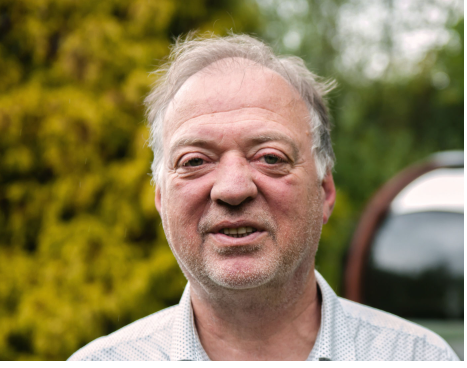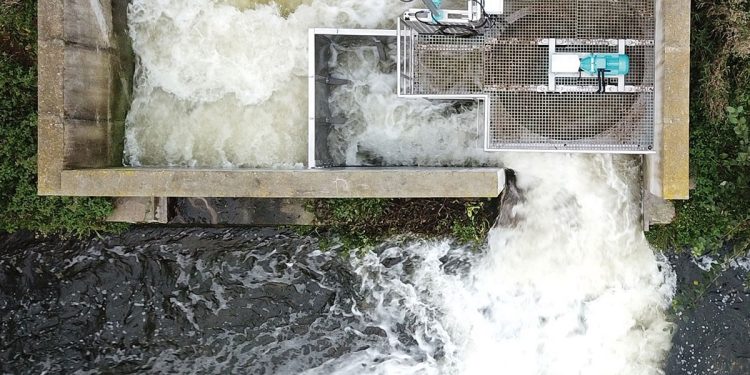“Our mini-turbine generates as much energy as an entire football field with solar panels,” says Walter Buydens (63), who became CEO of the Flemish water turbine builder Turbulent in June 2021.
The start-up from 2015 had sold four installations by 2022, respectively of 15 kW, 30 kW, 50 kW and 70 kW. “Today, the company already has sixteen turbines with an average of 50 kW.”
“I had the drive to do something about food security in Africa. Then you end up with an agricultural engineer,” says Buydens, who started his studies in Leuven in 1976. Today that is called bioengineering. Grandfather was a farmer. “In the summer we went to lend a hand.” The vegetable and herb garden at home fascinated him. But it is mainly the hunger images of Biafra (1967-70), Bangladesh (1970) … and the Club of Rome (Limits to growth, 1972) that have stirred deeply.
“The predicted population explosion has meanwhile happened. How do we control further population growth? It is one of nature’s great problems. How do we secure the ‘other beasts’? You only see animals in cages. We notice that there are far fewer insects. Are we going to breed insects then? They are all ticking time bombs. When it becomes urgent, when it is really urgent, it is too late.”
Phytotechnics and hydroponics
Phytotechnics, the technique of growing plants, and hydroponics fascinated him. It was also the time of the computing center and computers that ran on punched cards. For his thesis he simulated the growth of winter wheat.
“Growth models could already estimate the harvest with an accuracy of 10%.” As a fresh agricultural engineer with a specialization in water, he immediately started working in 1981 as a hydrographic assistant at the Ministry of Public Works. He mapped wrecks and sandbanks in the North Sea. “I was appointed there but … there were still so many things to do in life,” he smiles.
Soon he received a grant for the IHE Delft Institute for Water Education. “An international, multidisciplinary study with attention to economic and financial aspects.” With this second MA equivalent in his pocket, he was able to obtain his doctorate in artificial intelligence in Delft in 1984. But at the same time he got the chance to work in Niger.
“If I don’t leave now, he thought, I will never gain international experience in ‘emerging’ economies.” And he was gone. As a hydrologist at the World Meteorological Organization (WMO), he monitored the rivers and the drought in the Sahel belt. On his own he simulated the deflation of the Niger. He concluded that the stream would run dry.
That had never happened before. When he rang the bell, he experienced only disbelief and resistance from the French bosses. “I calculated five months in advance that the river would empty on May 5, 1984. I was off for two days.”
More weight in the bowl
Then he decided to get a doctorate after all. Angry because he was misunderstood. With a doctorate, he wanted to be able to put more weight in the balance. “To have an impact. I had also seen what “development” meant. The French were in Niger for the uranium mines, not for the Nigerien budding.”
In 1987, six years after his first graduation, he went to Cornell University (NY, USA) to do a doctorate in hydraulic engineering and the optimization of water resources. “I also taught there as a scientific assistant, so I didn’t have to pay a registration fee. At the same time, he started working as a freelance consultant at the World Bank’s new environmental division.
He had married a year earlier and his wife had followed him to Niger. “We held a big African party there.” She was graduating and worked in Niger as a graphic designer. She made drawings of dinosaurs found in the desert. In the US she worked as a pharmacist’s assistant, designed wooden billboards and worked in the Cornell library. Sturdy for a young family.
“In the third year we went to India for my field research.” Major irrigation projects, water resources, environmental impact, economics and social fairness… “The predictive power of models continued to interest me. I applied them in India, where I also included social aspects, such as the optimization of water use and theft of water, in my formulas.”
Management and sales
Once that PhD cap was passed, the family returned to Belgium at the end of 1991. He took over the management of the environmental consultancy firm ARIES/Royal Haskoning. “That catapulted me into management and sales.”
That was new. It was their intention to eventually return to the tropics, but that did not happen. Their first son was born. Stability was needed. At Haskoning it was starting from scratch. After three years, Buydens also pioneered the American-English ERM as a managing partner. First in Belgium and later, from 2001, also in France and the Netherlands.
People were talking about ERM Gaul. “It was one of my best experiences. You start with a few people and suddenly it works. The Soil Decree was on its way and we informed garage owners and car dealers. We were ahead of the legislation. From there we grew into other domains such as environmental education. We saw the fruit of our labor. You could “harvest”.
That’s enjoyment. Party. It was also international.” Along the way, in 1997-98, Buydens took a few short courses at Insead “which really pleased me. I can recommend something like this to everyone. If you run a company, you don’t have to immediately follow an MBA, but it is still useful to be offered practical things that are related to the job.”
New mission
“After twelve years, my mission was over.” He was 49, received quite a few offers but felt too identified with ERM. He opted for change and the rapidly growing ABO where he helped with their change management. Not a year later, Royal Haskoning gave him the opportunity to take Belgium and the Netherlands, and then also the environmental division, worldwide.
“I could manage 480 people.” It took him to Vietnam, Indonesia, Ukraine, Gabon, the Balkans, Romania. He also founded the office in Doha -Qatar-. One thing led to another. Three years later, in 2014, Vito contracted him to set up Vito Middle East and later VITO Arabia LLC in the UAE from the same Doha.
“Those commercial positions kept me in the Middle East for eight years.” Every three to five weeks he commuted between work and family. Then he was offered the position of Group CEO of the Belgian asbestos remover Care for Future. Two years later, in June 2021, he was headhunted as CEO for the Flemish Turbulent.
Vortex
Turbulent’s average turbine is good for 50 kW. “But we are also looking at pico turbines from 800 W to 5 kW,” says Buydens, whose attention as CEO is now mainly focused on the capital increase. This is to increase production, but also to offer a new service: Hydra As A Service (HAAS).
“In addition to kW, we also want to be able to sell kWh. The customer then pays less in purchase, but we partly share the risk of the proceeds. Our technology is at TRL 9. That means it has to be rolled out now.” He reckons that the engineers still devote 20% of their time to R&D. “They are on board to standardize now.” On the other hand, they still come into action with every project.
“We calculate the size of the blades, how slow or fast it will run, the size of the generator and gearbox.” Part of the civil engineering works could be prefabricated, he admits, but… It’s not as easy as dropping a swimming pool in a pelouze. Every situation is slightly different. The company monitors the work and also takes care of maintenance afterwards.
“We create a vortex and convert that potential energy into energy with a horizontally rotating watermill. We achieve 65% efficiency from the potential energy to the socket.” He compares with sun (18%) and wind (20%). “We are much higher. The Levellized Cost of Energy (LCOE) of our turbine is 4 euro cents per kWh. We are a good competitor of solar energy.
“Our 75 kW turbine produces as much as an entire football field with solar panels and we don’t have to use rare earth materials for that.”
Fish-friendly
“We generate energy in an ecologically responsible manner.” The power stations are ‘low’ (no visual disturbance of the landscape) and the turbine grinds slowly under water, so silently. The turbine is also fish friendly.
The relative speed of the fish is the same. The pressure difference between the water flowing in and what comes out is minimal. Barely 0.1 bar. With a traditional Kaplan turbine, on the other hand, that difference is 2 to 3 bar. Such sudden pressure differences tear the internal organs of fish apart. Not so with Turbulent. Buydens is not immediately afraid of competition.
Moreover, the technology, which is patented (application in 2016, granted in 2021), is not that easy to copy. Meanwhile, the R&D department is adapting the turbines to climate change.
“The flow of streams and rivers will change. We make our turbines climate change proof.” The average cost nowadays fluctuates around 3,000 euros per kW. The turbine can reach an efficiency of more than 60%. This ensures short repayment terms.
The path of least resistance
“In Belgium, we calculated, there is a possible capacity of up to 3 GW.” The biggest obstacle here are the (environmental) permits. “The administration is not familiar with microhydra. One immediately thinks of giant dams that would require entire populations to disappear…
We are therefore mainly active here in Wallonia, where things are a bit easier administratively than in Flanders. But also in France and England. I walk the path of least resistance.” Elsewhere, where an installation will be installed on irrigation canals, with examples in Taiwan and Congo, or at the outlet of water purification installations, such as one in the French Versailles for Suez that has been running for several years now, it turned out to be much easier.
“We get a lot of requests. This year alone, about 3,000”, Buydens counts, who also mentions the problem of reactive sales: “Who do we invest our time in? I want to carry out active marketing in seven to ten countries. We are now reorganizing the sales department for this.” Then, of course, production must be able to follow “but there is still a lot of elasticity there. We are also starting to outsource some.”
Delivery terms are five to seven months. Partners worldwide, typically there are agreements with so-called Independent Power Producers, receive training from Leuven. “We manage to solve most cases through video conferencing.”
Profitability depends on large scale
By the end of 2023, the company plans to switch on 1.6 MW. It wants to reach 10 MW in 2025. 2022 wants to round it off with a turnover of 1.2 million euros, which will be around 4 million euros in 2023, to be scaled to 20 million euros by 2025. “To really grow, we have to be able to work in clusters and install up to 10 MW for one and the same customer.”
Buydens sees the future in increasingly larger projects. The profitability of the company will depend on scale. But that requires money. He is now looking for 2 to 2.5 million euros from ‘impact investors’ and ‘friends’ of Turbulent, who are willing to take risks. He hopes to complete this capital round by mid-November.
In a subsequent round, he is aiming for 10 to 15 million euros to further strengthen the HAAS formula. “Then the generated electricity will yield royalties, kWh income, but spread over years. That has to be bridged with capital. Unless we can generate it ourselves with our turbines.”
The geopolitical and market economic uncertainty today creates a difficult climate to find money. “On the other hand, everyone is short of energy. That’s the benefit.”
Payback time of 2.5 to 4 years
The commercial focus is no longer on developing countries. The first turbines were installed in Estonia, near Paris, Chile and Bali. Today there are going to the US, UK, Portugal, Congo, Thailand and Taiwan.
“We cluster several turbines of 50 kW and 75 kW installations on a stretch of the river. We can now achieve up to 400 kW in cascade. Our installations have a payback period of 2.5 to 4 years. They last 30 years. That is precisely why it is interesting to work via the HAAS formula and to collect part of the electricity yield ourselves.”
Maintenance is minimal. Change the oil every year and the turbine every ten years. “We monitor all installations from Leuven. If a problem arises, we can deal with it preventively.” Turbulent currently employs seventeen people, representing thirteen full-time equivalents. Mechanical, electrical and structural engineers.
A source: https://engineeringnet.be











